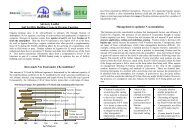Green Manures booklet - Institute of Organic Training and Advice
Green Manures booklet - Institute of Organic Training and Advice
Green Manures booklet - Institute of Organic Training and Advice
You also want an ePaper? Increase the reach of your titles
YUMPU automatically turns print PDFs into web optimized ePapers that Google loves.
4.5.7. Root knot nematode<br />
Root knot nematode (Meloidogyne spp.) is a major pest <strong>of</strong> vegetable crops <strong>and</strong> potatoes. Fertility building<br />
legumes such as clover (Hallman, 2005) <strong>and</strong> common vetch (Guertal et al., 1998) can act as a host to the pest.<br />
However green manures may suppress numbers <strong>of</strong> nematodes as cereals <strong>and</strong> grasses have been found to be less<br />
favourable (McBride et al., 1999; Leroux et al., 1996). Some incorporated residues, such as rye have a<br />
nematicidal action, significantly reducing nematode populations (McBride et al., 1999). Brassica residues can<br />
also suppress nematode numbers, <strong>and</strong> particular attention has been paid to caliente varieties with high<br />
glucosinilate content, the precursor which breaks down to isothiocyanate when the green manure is incorporated.<br />
Much <strong>of</strong> this work has already been reviewed by Hockl<strong>and</strong> (HDC project FV 273) who concluded that the<br />
biocidal effects were highly variable. This variation could be attributed to variety (not always specified in<br />
published work), soil type, climate conditions <strong>and</strong>, most importantly, the method <strong>of</strong> incorporation. It is in general<br />
agreement that rapid incorporation is essential for the biocidal properties <strong>of</strong> brassicas to be effective.<br />
4.5.8. Cabbage root fly<br />
Cabbage root fly (Delia radicum) is a serious pest with the potential to cause widespread economic damage to<br />
brassica crops (Coaker <strong>and</strong> Finch, 1971). It is now well accepted that growing a crop with another species, such<br />
as a green manure can decrease pest infestations significantly (O'Donnell & Coaker, 1975; Finch & Edmonds,<br />
1993). Finch & Collier (2000) proposed that this is because the presence <strong>of</strong> a non-host plant species reduces pest<br />
colonisation. Consistent with this, they observed a 36-82% reduction in egg-laying by the cabbage root fly when<br />
cauliflowers were planted amongst 24 other non-host plant species (Finch, et al., 2003).<br />
However, care must be taken that the green manure does not compete against the brassica crop as there are many<br />
instances where undersowing with clover have resulted in yield penalties <strong>of</strong> 30-40% (Finch & Edmonds, 1993).<br />
Less vigorous species such as yellow trefoil, subterranean clover <strong>and</strong> birdsfoot trefoil should be used to<br />
minimise this effect. An alternative approach <strong>of</strong> sowing companion plants in the modules <strong>of</strong> brassica plants is<br />
also being investigated (Rosenfeld et al., 2006, see also HDC project FV 251) as a means <strong>of</strong> targeting<br />
companion plants more effectively to reduce competitive effects.<br />
4.5.9. Disease control<br />
It is well established that green manures can suppress disease although these effects are variable <strong>and</strong> the<br />
mechanisms not fully understood. The way in which green manures suppress disease fall broadly into two<br />
categories: green manures can either provide organic matter to sustain microbial communities that suppress<br />
pathogens or the green manure may have a direct biocidal effect on the pathogen.<br />
<strong>Green</strong> manures may support microbial communities <strong>of</strong> bacteria, non-pathogenic Fusarium species, streptomyces<br />
<strong>and</strong> other actinomycetes. These can suppress pathogens though competition, antiobiosis, parasitism or by<br />
inducing systemic resistance in plants (Hoitink & Boehm, 1999). There are numerous examples in the literature<br />
<strong>of</strong> green manures being effective against vegetable diseases eg lucerne hay against Sclerotinia sclerotiorum in<br />
lettuce (Asirifi et al., 1994), lucerne residues on common root rot <strong>of</strong> pea (Aphanomyces eutieches) (Williams-<br />
Woodward et al., 1997) <strong>and</strong> buckwheat against common scab (Streptomyces scabies) <strong>and</strong> verticillium wilt <strong>of</strong><br />
potatoes (Wiggins & Kinkel, 2005).<br />
Direct biocidal effects have most commonly been observed in brassica green manures containing high levels <strong>of</strong><br />
glucosinilates. As with nematode control, fungicidal activity depends on glucosinilate content <strong>and</strong> method <strong>of</strong><br />
incorporation. There are many such examples including control <strong>of</strong> Rhizoctonia solani in vegetable crops<br />
(Villeneuve et al., 2004) <strong>and</strong> sclerotinia wilt in lettuces (Pung et al., 2005). The latter found that disease<br />
incidence was negatively correlated to the glucosinilate content <strong>of</strong> the preceding brassica green manure.<br />
Although green manures can act as a disease suppressive agent, care must be taken that they do not also act as a<br />
green bridge for diseases. The most obvious danger <strong>of</strong> this is growing a brassica green manure such as mustard<br />
in a rotation that already contains brassicas, as this will greatly increase the risk <strong>of</strong> introducing persistent soilborne<br />
diseases such as clubroot (Plasmodium brassicola).<br />
The use <strong>of</strong> green manures<br />
24




